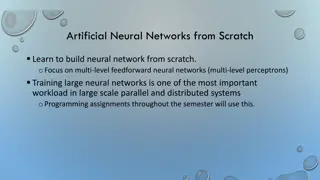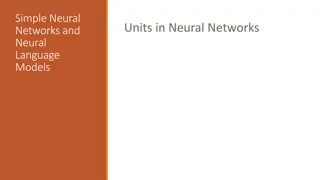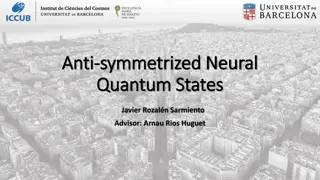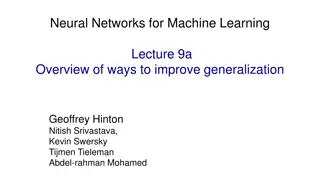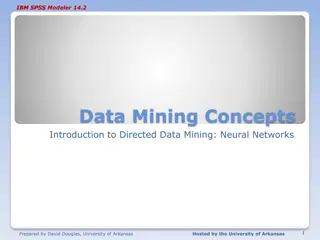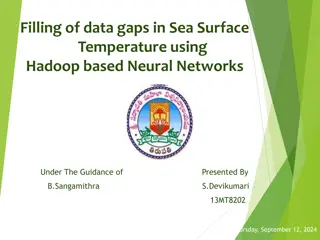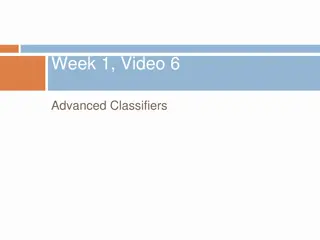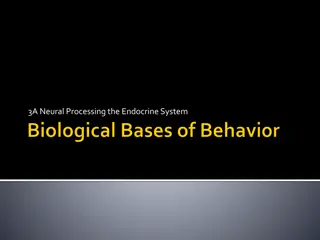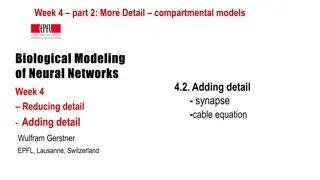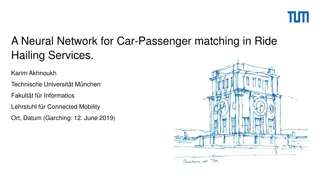Analyzing Neural Network Initialization Methods
An empirical study investigates various neural network initialization methods using the Neural Tangent Kernel. Topics include orthogonal initialization, dynamical isometry, and the Neural Tangent Kernel's role in deep learning dynamics and generalization.
Download Presentation

Please find below an Image/Link to download the presentation.
The content on the website is provided AS IS for your information and personal use only. It may not be sold, licensed, or shared on other websites without obtaining consent from the author.If you encounter any issues during the download, it is possible that the publisher has removed the file from their server.
You are allowed to download the files provided on this website for personal or commercial use, subject to the condition that they are used lawfully. All files are the property of their respective owners.
The content on the website is provided AS IS for your information and personal use only. It may not be sold, licensed, or shared on other websites without obtaining consent from the author.
E N D
Presentation Transcript
1 On the Neural Tangent Kernel of Deep Networks with Orthogonal Initialization Wei Huang, Weitao Du, and Richard Yi Da Xu IJCAI 2021 Presenter : Jaechang Kim, Jabin Koo
2 Introduction Project Topic: An Analysis of Neural Network Initializations using Neural Tangent Kernel. Paper Title: On the Neural Tangent Kernel of Deep Networks with Orthogonal Initialization Summary of topic: Empirical study on various neural network initialization methods with Neural Tangent Kernel
3 Contents Paper Backgrounds Motivation Theoretical results Experimental results Conclusion Project Motivation Method
4 Background: Neural Network Initializations There are various ways of neural network initializations in used. Constant Initialization Gaussian distribution Uniform distribution Orthogonal Initialization Depending on the layer width and the activation function, different initializations are known to be effective.
5 Background: Orthogonal Initialization Orthogonal initialization initializes neural network weights as orthogonal matrices. i.e), ??? = ?. It is known that orthogonal initialization speeds up training of deep neural networks due to Dynamical Isometry and is especially useful in recurrent neural networks.
6 Background: Dynamical Isometry When a neural network achieves dynamical isometry, the gradients avoid exploding/vanishing gradients. Dynamical Isometry happens when the singular values of the input-output Jacobian for weight matrices equal one. Recent researches suspect that orthogonal Initialization achieves the dynamical isometry. Theoretically well-proven for linear networks, but not for non-linear networks. Dynamical Isometry and a Mean Field Theory of CNNS: How to Train 10,000-Layer Vanilla Convolutional Neural Networks, ICML 2018
7 Background: Neural Tangent Kernel In the infinite-width scheme, a training dynamics of neural network is approximated by a kernel, named Neural Tangent Kernel, which converges into a deterministic kernel. Recently, NTK framework is being used as a theoretical backgrounds for understanding deep learning. Why Do Deep Residual Networks Generalize Better than Deep Feedforward Networks? --- A Neural Tangent Kernel Perspective, NeurIPS 2020 Fourier Features Let Networks Learn High Frequency Functions in Low Dimensional Domains, NeurIPS 2020
8 Background: Kernel Regression Kernel Regression : regression by weighted averaging, using a kernel as weighting function. ?(??,??) : kernel function, which represents a distance between ??and ?? K : an n x n matrix with entries For a training dataset , kernel regression can be noted as : It is import to choose a proper kernel function!
9 Background: Neural Tangent Kernel Training a neural network is approximated as a kernel regression: with infinity-width assumption, Inference at t-th iteration is approximated as : ?test is the NTK matrix between all points in ?test and all points in the train set ?. ? is a step size. Note that NTK is a linear approximation over t. Arthur Jacot et al., Neural Tangent Kernel: Convergence and generalization in neural networks, NeurIPS 2018 Jaehoon Lee et al., Wide neural networks of any depth evolve as linear models under gradient descent, NeurIPS 2019
10 Motivation Orthogonal initialization speed up training of neural networks. For linear network, orthogonal initialization achieves dynamical isometry. For deep non-linear networks, it is not supported theoretically. The authors expected the emerging theoretical framework, NTK explains the advantage of orthogonal initializations. However, original NTK is derived based on gaussian initialization of weights. This work investigate the difference between NTK with gaussian initializations and NTK with orthogonal initializations.
11 Theoretical results Theoretically NTK of orthogonal and Gaussian initialization converges to the same deterministic kernel of a network initialized in the infinite-width.
12 Theoretical results NTK of a network with an orthogonal initialization stays asymptotically constant during gradient descent training, providing a guarantee for loss convergence.
13 Numerical Experiments Numerical experiment on Gaussian and Orthogonal initialization is also experimented with CIFAR10 and MNIST dataset. As expected, in shallow networks, two initialization methods are similar. But for deep neural network, which is far from assumptions of NTK, orthogonal initialization showed faster convergence and higher generalization performance. shallow networks deep networks with large learning rate
14 Conclusion Theoretically NTK of orthogonal and Gaussian initialization converges to the same deterministic kernel of a network initialized in the infinite-width. NTK of orthogonal and gaussian initializations of different architectures varies at a rate of the same order. Theoretically dynamics of wide networks behaves similarly in orthogonal initialization and Gaussian initialization. However numerically orthogonal initialization actually performs better in large learning rate, but not explained by NTK.
15 Project Topic Title: An Analysis of Neural Network Initializations using Neural Tangent Kernel. Motivation: Initialization is known to be very important in the training dynamics of deep neural networks. NTK is expected to be sensitive to initialization methods as lazy regime of NTK is first order approximation near its initialization value.
16 Project method Method: Roughly analyze the effect of different initialization methods such as with NTK. Empirically compare NTK of networks with different initializations. Target initializations: Constant initialization, i.e.) 0, 1 initialization Random initializations with different means and variances Orthogonal initialization Xavier, He initializations depending on activation functions.
17 Thanks for listening :)







